HydroKid239
Well-Known Member
Author to whom correspondence should be addressed.
Plants 2023, 12(5), 1061; https://doi.org/10.3390/plants12051061
Received: 13 January 2023 / Revised: 14 February 2023 / Accepted: 14 February 2023 / Published: 27 February 2023
(This article belongs to the Special Issue Studies on Cannabis sativa and Cannabinoids)
Abstract
The standard practice to initiate flowering in medicinal cannabis involves reducing the photoperiod from a long-day period to an equal duration cycle of 12 h light (12L)/12 h dark (12D). This method reflects the short-day flowering dependence of many cannabis varieties but may not be optimal for all. We sought to identify the effect of nine different flowering photoperiod treatments on the biomass yield and cannabinoid concentration of three medicinal cannabis varieties. The first, “Cannatonic”, was a high cannabidiol (CBD)-accumulating line, whereas the other two, “Northern Lights” and “Hindu Kush”, were high Δ9-tetrahydrocannabinol (THC) accumulators. The nine treatments tested, following 18 days under 18 h light/6 h dark following cloning and propagation included a standard 12L:12D period, a shortened period of 10L:14D, and a lengthened period of 14L:10D. The other six treatments started in one of the aforementioned and then 28 days later (mid-way through flowering) were switched to one of the other treatments, thus causing either an increase of 2 or 4 h, or a decrease of 2 or 4 h. Measured parameters included the timing of reproductive development; the dry weight flower yield; and the % dry weight of the main target cannabinoids, CBD and THC, from which the total g cannabinoid per plant was calculated. Flower biomass yields were highest for all lines when treatments started with 14L:10D; however, in the two THC lines, a static 14L:10D photoperiod caused a significant decline in THC concentration. Conversely, in Cannatonic, all treatments starting with 14L:10D led to a significant increase in the CBD concentration, which led to a 50–100% increase in total CBD yield. The results show that the assumption that a 12L:12D photoperiod is optimal for all lines is incorrect as, in some lines, yields can be greatly increased by a lengthened light period during flowering.
Plants 2023, 12(5), 1061; https://doi.org/10.3390/plants12051061
Received: 13 January 2023 / Revised: 14 February 2023 / Accepted: 14 February 2023 / Published: 27 February 2023
(This article belongs to the Special Issue Studies on Cannabis sativa and Cannabinoids)
Abstract
The standard practice to initiate flowering in medicinal cannabis involves reducing the photoperiod from a long-day period to an equal duration cycle of 12 h light (12L)/12 h dark (12D). This method reflects the short-day flowering dependence of many cannabis varieties but may not be optimal for all. We sought to identify the effect of nine different flowering photoperiod treatments on the biomass yield and cannabinoid concentration of three medicinal cannabis varieties. The first, “Cannatonic”, was a high cannabidiol (CBD)-accumulating line, whereas the other two, “Northern Lights” and “Hindu Kush”, were high Δ9-tetrahydrocannabinol (THC) accumulators. The nine treatments tested, following 18 days under 18 h light/6 h dark following cloning and propagation included a standard 12L:12D period, a shortened period of 10L:14D, and a lengthened period of 14L:10D. The other six treatments started in one of the aforementioned and then 28 days later (mid-way through flowering) were switched to one of the other treatments, thus causing either an increase of 2 or 4 h, or a decrease of 2 or 4 h. Measured parameters included the timing of reproductive development; the dry weight flower yield; and the % dry weight of the main target cannabinoids, CBD and THC, from which the total g cannabinoid per plant was calculated. Flower biomass yields were highest for all lines when treatments started with 14L:10D; however, in the two THC lines, a static 14L:10D photoperiod caused a significant decline in THC concentration. Conversely, in Cannatonic, all treatments starting with 14L:10D led to a significant increase in the CBD concentration, which led to a 50–100% increase in total CBD yield. The results show that the assumption that a 12L:12D photoperiod is optimal for all lines is incorrect as, in some lines, yields can be greatly increased by a lengthened light period during flowering.


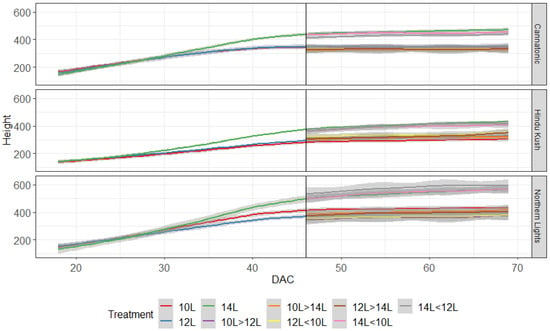
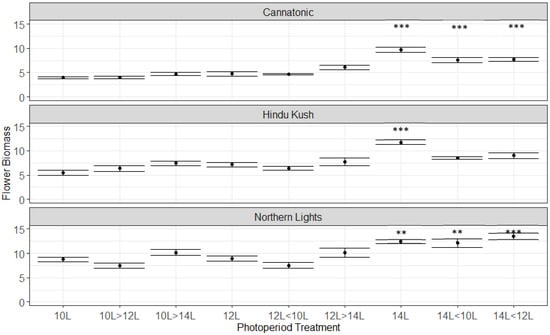
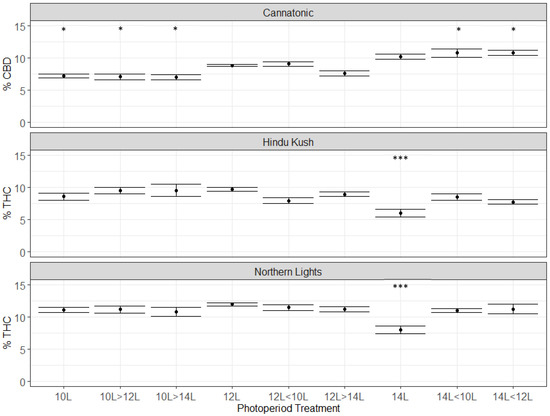
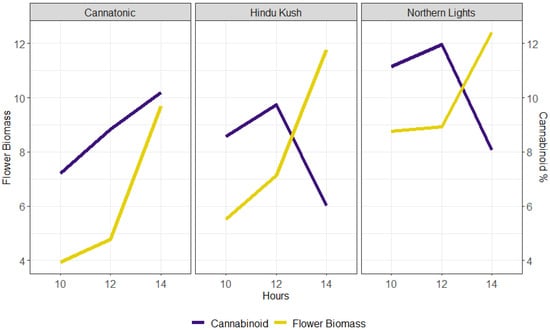
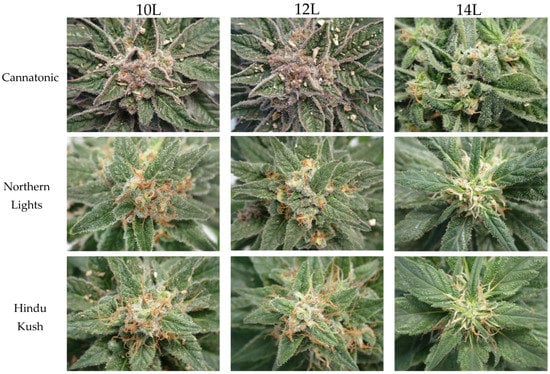
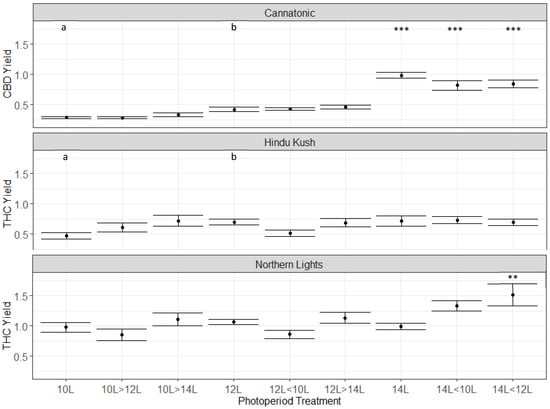
 in flower.
in flower.